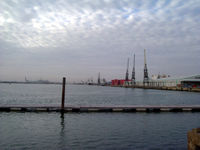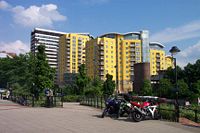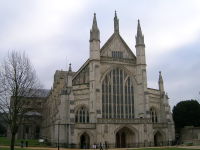Hampshire
2008/9 Schools Wikipedia Selection. Related subjects: Geography of Great Britain
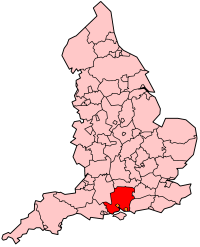 |
|
| Geography | |
| Status | Ceremonial & (smaller) Non-metropolitan county |
|---|---|
| Region: | South East England |
| Area - Total - Admin. council - Admin. area |
Ranked 9th 3,769 km² Ranked 8th 3,679 km² |
| Admin HQ: | Winchester |
| ISO 3166-2: | GB-HAM |
| ONS code: | 24 |
| NUTS 3: | UKJ33 |
| Demographics | |
| Population - Total (2006 est.) - Density - Admin. council - Admin. pop. |
Ranked 5th 1,691,000 449 / km² Ranked 3rd 1,266,000 |
| Ethnicity: | 96.7% White 1.3% S. Asian 0.8% Mixed 1.2% Other |
| Politics | |
| Hampshire County Council http://www.hants.gov.uk/hcc/ |
|
| Executive | Conservative |
| Members of Parliament |
|
| Districts | |
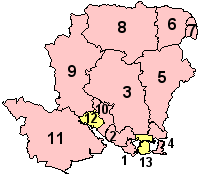
|
|
Hampshire (pronounced /'hæmpʃɪə/, listen ), sometimes historically Southamptonshire, Hamptonshire, (abbr. Hants), or the County of Southampton, is a county on the south coast of England. The county borders (clockwise from West), Dorset, Wiltshire, Berkshire, Surrey and West Sussex. The county has an area of 1,455 square miles (3,769 km²) and at its widest points is approximately 55 miles (90 km) east–west and 40 miles (65 km) north–south. The county town is Winchester situated at . The 2001 census gave the population of the administrative county as 1.24 million; the ceremonial county also includes the cities of Portsmouth and Southampton, which are administratively independent, and has a total population of 1.6 million. Christchurch and Bournemouth, within the historic borders of the county, were made part of the non-metropolitan county of Dorset in 1974.
Hampshire is a popular holiday area, with tourist attractions including its many seaside resorts, the maritime area in Portsmouth, and the motor museum at Beaulieu. The New Forest National Park lies within the borders, as does a large area of the South Downs, which is also scheduled to become a National Park. Hampshire has a long maritime history and two of England's largest ports lie on its coast. The county is famed as home of writers Jane Austen and Charles Dickens.
Wildlife
Hampshire has the typical wildlife of the British area as it does not have a very different climate. The one distinguishing fact is that Hampshire has the largest free roaming herd of stag in the eastern hemisphere, including more than 6500 stags during busy seasons. The stag population is protected by the government and hunting is prohibited.
Physical geography
Hampshire's geology falls into two categories. In the south, along the coast is the " Hampshire Basin", an area of relatively non-resistant Eocene and Oligocene clays and gravels which are protected from sea erosion by the Isle of Purbeck, Dorset, and the Isle of Wight. These low, flat lands support heathland and woodland habitats, a large area of which form part of the New Forest. The New Forest has a mosaic of heathland, grassland, coniferous and deciduous woodland habitats that host diverse wildlife. The forest is protected as a national park, limiting development and agricultural use to protect the landscape and wildlife. Large areas of the New Forest are open common lands kept as a grassland plagioclimax by grazing animals, including domesticated cattle, pigs and horses, and several wild deer species. Erosion of the weak rock and sea level change flooding the low land has carved several large estuaries and rias, notably the 12 mile (19 km) long Southampton Water and the large convoluted Portsmouth Harbour. The Isle of Wight lies off the coast of Hampshire where the non-resistant rock has been eroded away forming the Solent.
In the north and centre of the county the substrate is the Southern England Chalk Formation of Salisbury Plain and the South Downs. These are high hills with steep slopes where they border the clays to the south. The hills dip steeply forming a scarp onto the Thames valley to the north, and dip gently to the south. The highest point in the county is Pilot Hill, which reaches the height of 286 m (938 ft). The downland supports a calcareous grassland habitat, important for wild flowers and insects. In the past Hampshire had little agriculture, but in the early 20th century the demand for food led to the establishment of farms on the downs. A large area of the downs is now protected from further agricultural damage by the East Hampshire Area of Outstanding Natural Beauty. The Itchen and Test are trout rivers that flow from the chalk through wooded valleys into Southampton Water. Nestled in a valley on the downs is Selborne, and the countryside surrounding the village was the location of Gilbert White's pioneering observations on natural history. Hampshire's county flower is the Dog Rose.
Hampshire has a milder climate than most areas of the British Isles, being in the far south with the climate stabilising effect of the sea, but protected against the more extreme weather of the Atlantic coast. Hampshire has a higher average annual temperature than the UK average at 9.8 °C to 12 ° C, average rainfall at 741–1060 mm per year, and higher than average sunshine at over 1541 hours per year.
History
The chalk downland of the South Downs and southern edges of Salisbury Plain were settled in the neolithic, and these settlers built hill forts such as Winklebury and may have farmed the valleys of Hampshire. Hampshire was part of an area named Gwent or Y Went by the Celts, which also covered areas of Somerset and Wiltshire. In the Roman invasion of Britain, Hampshire was one of the first areas to fall to the invading forces. The county was occupied by Jutish tribes until Saxon times. Hampshire was one of the first Saxon shires, recorded in 755 as Hamtunscir,
Portsmouth and Winchester have the highest job densities in the county, and therefore there is a high level of commuting into the cities. Southampton has the highest number of total jobs and commuting both into and out of the city is high. The county has a lower level of unemployment than the national average, at 1.9% when the national rate was 3.3%, and as of March 2005 has fallen to 1.1%. 39% are employed by large firms, compared with a national average of 42%. Hampshire has a considerably higher than national average employment in high-tech industries, but average levels in knowledge based industry. 25.21% of the population work in the public sector.
Many rural areas of Hampshire have traditionally been reliant on agriculture, though the county was less agricultural than most surrounding counties, and was mostly concentrated on dairy farming. The significance of agriculture as an employer and wealth creator has declined since the first half of the 20th century and agriculture currently employs 1.32% of the population.
The New Forest area is a National Park, and tourism is a significant economic segment in this area, with 7.5 million visitors in 1992. The South Downs and the cities of Southampton and Winchester also attract tourists to the county. Southampton Boat Show is one of the biggest annual events held in the county, and attracts visitors from throughout the country. In 2003 the county had a total of 31 million day visits, and 4.2 million longer stays.
The cities of Southampton and Portsmouth are both significant ports, with Southampton handling a large proportion of the national container freight and Portsmouth housing a large Royal Navy base. The docks have traditionally been large employers in these cities, though again mechanisation has forced diversification of the economy.
Demographics
At the Census 2001 the ceremonial county recorded a population of 1,644,249, of which 1,240,103 were in the administrative county, 217,445 were in the unitary authority of Southampton, and 186,701 were in Portsmouth. The population of the administrative county grew 5.6% from the 1991 census, Southampton grew 6.2% while Portsmouth remained unchanged, compared with 2.6% for England and Wales as a whole. Eastleigh and Winchester grew fastest at 9% each. The age structure of the population is similar to the national average.
96.73% of residents were indigenous, falling to 92.37% in Southampton. The significant ethnic minorities are Asian at 1.34% and mixed race at 0.84%. 0.75% of residents were migrants from outside the UK. 73.86% stated their religion as Christianity and 16.86% were not religious. Significant minority religions were Islam (0.76%) and Hinduism (0.33%).
Education
The school system in Hampshire (including Southampton and Portsmouth) is comprehensive. Geographically inside the Hampshire LEA are twenty four independent schools, Southampton has three and Portsmouth has four. Few Hampshire schools have sixth forms, which varies by district council.
Politics
Hampshire is divided into eighteen parliamentary constituencies. Ten of these are represented by Conservative Members of Parliament (MPs), four by the Liberal Democrats and three by Labour. Labour represent the large cities, including both Southampton constituencies ( Test and Itchen) and Portsmouth North. The Conservatives represent the most rural constituencies, New Forest West, New Forest East, Hampshire North West, Hampshire North East, Hampshire East and the constituencies of Aldershot, Basingstoke, Havant, Gosport and Fareham, which are centred on towns. The Liberal Democrats represent Winchester, Portsmouth South and Eastleigh, all centred around towns, and the largely rural constituency of Romsey. There is a new parliamentary constituency to be contested at the next general election as part of the new boundary changes. The Meon Valley constituency is notionally a Conservative seat.
The Isle of Wight returns its own Member to the House of Commons and, in this way, it is often said that Hampshire returns nineteen Members of Parliament despite Hampshire and the Isle of Wight having been separated administratively and ceremonially for some time.
At the 2005 local elections for Hampshire County Council the Conservative Party had a 43.69% share of the votes, the Liberal Democrats had 36.01% and Labour 16.08%. Therefore 46 Conservatives, 28 Liberal Democrats and four Labour councillors sit on the County Council. Southampton City Council, which is entirely independent, has 18 Liberal Democrat, 15 Labour and 15 Conservative councillors. Portsmouth City Council, also independent, has 20 Liberal Democrat, 18 Conservative, seven Labour and one independent councillor.
Hampshire also has its own County Youth Council (HCYC) and is an independent youth-run organisation. It meets once a month around Hampshire and aims to give the young people of Hampshire a voice. It also has numerous district and burough youth councils including Winchester's "Youth Of Winchester"
Cities, towns, and villages
Hampshire's county town is Winchester, a historic city that was once the capital of the ancient kingdom of Wessex and of England until the Norman conquest of England. The port cities of Southampton and Portsmouth were split off as independent unitary authorities in 1997, although they are still included in Hampshire for ceremonial purposes. Fareham, Gosport and Havant have grown into a conurbation that stretches along the coast between the two main cities. The three cities are all university cities, Southampton being home to the University of Southampton and Southampton Solent University (formerly Southampton Institute), Portsmouth to the University of Portsmouth, and Winchester to the University of Winchester (formerly known as University College Winchester; King Alfred's College).
Hampshire lies outside the green belt area of restricted development around London, but has good railway and motorway links to the capital, and in common with the rest of the south-east has seen the growth of dormitory towns since the 1960s. Basingstoke, in the north of the county, has grown from a country town into a business and finance centre. Aldershot, Portsmouth, and Farnborough have strong military associations with the Army, Royal Navy and Royal Air Force respectively. The county also includes several market towns: Alton, Andover, Bishop's Waltham, Lymington, Petersfield, Ringwood, Romsey, and Whitchurch.
Towns by population size: (2001 census)
- Southampton - 234,224
- Portsmouth - 187,056
- Basingstoke - 90,171 (town), 152,573 (borough)
- Gosport - 69,348, 77,000 (borough)
- Waterlooville - 63,558
- Aldershot - 58,120
- Farnborough - 57,147
- Fareham/ Portchester - 56,010 (town), 109,619 (borough)
- Eastleigh - 52,894 (town), 116,177 (borough)
- Andover - 52,000
- Havant - 45,435 (town), 115,300 (borough)
- Winchester - 41,420
- Fleet - 32,726
Culture, arts and sport
Due to Hampshire's long association with pigs and boars, natives of the county have been known as Hampshire hogs since the 18th century. Hampshire has literary connections, being the birthplace of authors including Jane Austen and Charles Dickens, and the residence of others, such as Charles Kingsley. Austen lived most of her life in Hampshire, where her father was rector of Steventon, Hampshire, and wrote all of her novels in the county. Hampshire also has many visual art connections, claiming the painter John Everett Millais as a native, and the cities and countryside have been the subject of paintings by L. S. Lowry and J. M. W. Turner. Hampshire is also the birthplace of explorer Lawrence Oates, and entertainers Peter Sellers, Benny Hill, Carl Barat and Craig David.
Hampshire's relatively safe waters have allowed the county to develop as one of the busiest sailing areas in the country, with many yacht clubs and several manufacturers on the Solent. The game of cricket was largely developed in south-east England, with one of the first teams forming at Hambledon in 1750. Hampshire County Cricket Club today is a successful first-class team, captained by Dimitri Mascarenhas.
Hampshire has several association football teams, including Premier League side Portsmouth F.C. and Championship side Southampton F.C., which have traditionally been fierce rivals. Portsmouth won the FA Cup in 1939 and 2008 and Football League title on several occasions during the 1930s, 1940s and 1950s, but have spent much of the last 50 years outside the top division and at one stage spent two seasons in the Fourth Division (the lowest division in senior football). Southampton, meanwhile, have only won one major trophy to date (the FA Cup in 1976), even though they spent 27 unbroken years in the top division (1978- 2005).
Aldershot F.C. became members of the Football League in 1932 but never progressed beyond the Third Division and on 25 March 1992 were declared bankrupt and forced to resign from the league. A new football club, Aldershot Town, was formed almost immediately, and who were promoted from the Blue Square Premier Division (highest division outside the Football League) into Football League Two of the Football League in April 2008.
Thruxton Circuit is Hampshire's premier motor racing course with the National Motor Museum being located in the New Forest adjacent to Beaulieu Palace House. The Farnborough Airshow is a popular international event, held biennially.
Transport
Southampton Airport, with an accompanying main line railway station, is an international airport situated in the Borough of Eastleigh, close to Swaythling in the city of Southampton. Cross-channel and cross- Solent ferries link the county to the Isle of Wight and European continent. The South Western Main Line railway from London to Weymouth runs through Winchester and Southampton, and the Wessex Main Line from Bristol to Portsmouth also runs through the county.
The M3 motorway connects the county to London. The construction of the Twyford Down cutting near Winchester caused major controversy by cutting through a series of ancient trackways (the Dongas) and other features of archaeological significance. The M27 motorway serves a bypass for the major conurbations and as a link to other settlements on the south coast. Other important roads include the A3, A31 and A36.The roads in the county are known for their heavy traffic, especially around Southampton and Portsmouth and the M27 and A27.
The county has a high level of car ownership, with only 15.7% having no access to a private car compared with 26.8% for England and Wales. The county has a lower than average use of trains (3.2% compared with 4.1% for commuting) and buses (3.2% to 7.4%) but a higher than average use of bicycles (3.5% to 2.7%) and cars (63.5% to 55.3%).
